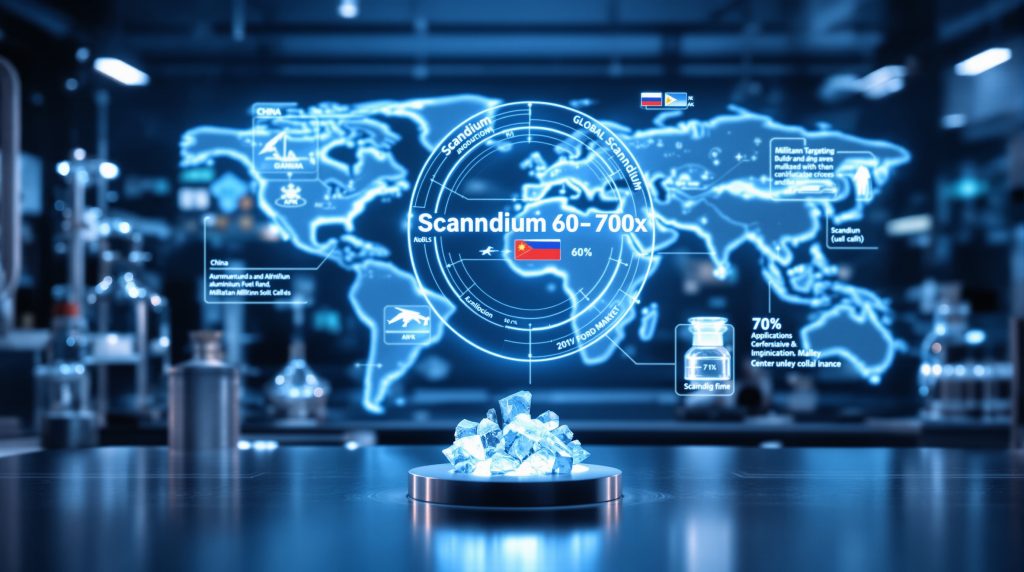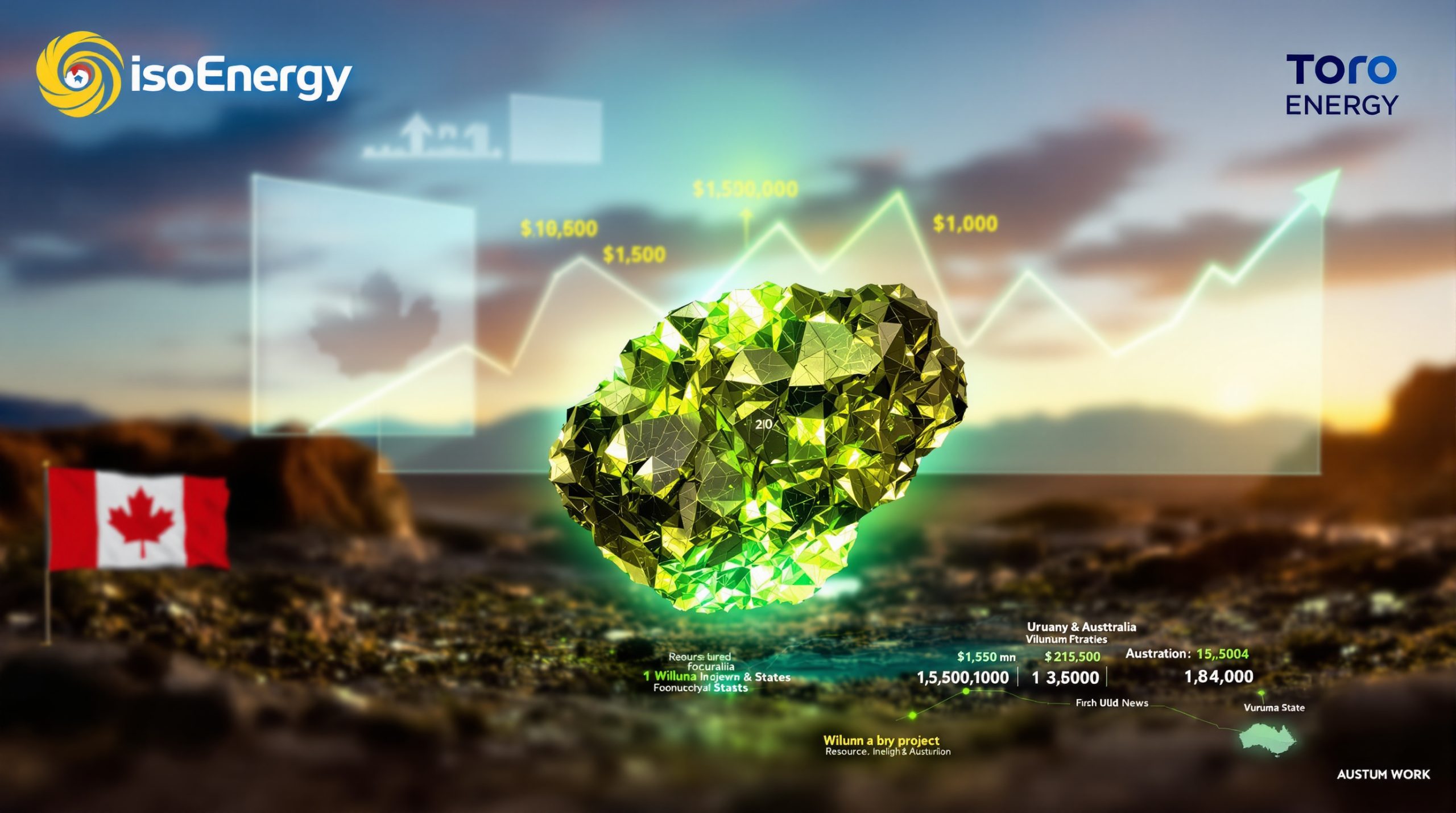Understanding the Scandium Oxide Supply Chain: Global Challenges and Strategic Solutions
What is Scandium Oxide and Why Does it Matter?
Scandium oxide (Sc₂O₃) serves as the primary commercial form of scandium, a rare earth element with exceptional properties that make it strategically important for advanced technology applications. Despite being classified as a rare earth element, scandium is more widely distributed in the Earth's crust than many other rare metals, but rarely concentrates in economically viable deposits.
This geological paradox creates unique supply chain challenges that have become increasingly relevant to national security considerations. With global production estimated at just 40 tonnes in 2024 according to the US Geological Survey, scandium remains one of the least abundant commercially produced metals in the world.
The strategic importance of scandium stems from its remarkable ability to enhance material properties, particularly in aluminum alloys and advanced ceramics. These properties have made scandium oxide a critical material for both defense-critical strategies and emerging clean energy technologies.
How is the Global Scandium Oxide Market Structured?
The scandium oxide supply chain operates differently from most commodity markets, with no transparent trading platform or public exchange. Instead, transactions occur through private negotiations between producers and end-users, creating a fragmented and opaque marketplace where pricing information is difficult to obtain.
Current global production capacity stands at approximately 80 tonnes annually according to recent reports, with actual production typically ranging between 40-50 tonnes. This limited supply base creates a market environment where even small disruptions can have significant impacts on availability and pricing.
Global Production Distribution by Region
| Region | Estimated Annual Production | Production Method | Market Share |
|---|---|---|---|
| China | 10-15 tonnes | Byproduct from titanium dioxide and REE processing | ~60-70% |
| Russia | 3-5 tonnes | Uranium mining byproduct | ~15-20% |
| Philippines | ~2 tonnes | Nickel laterite processing | ~10% |
| Canada | 3 tonnes | Titanium dioxide processing | ~7-8% |
| Others | <1 tonne | Various byproduct streams | <5% |
This concentrated production base, with China accounting for approximately two-thirds of global output, creates significant supply vulnerability for Western nations dependent on scandium for strategic applications.
What Challenges Face the Scandium Oxide Supply Chain?
Supply Concentration and Geopolitical Risks
The scandium oxide supply chain faces significant vulnerability due to geographic concentration. China dominated the global market until recently, controlling approximately 60-70% of production capacity. This concentration created substantial geopolitical market impacts, which became evident in late 2024 when China implemented export controls on scandium, severely disrupting global supply chains.
As noted in recent reporting, "China placed export controls on scandium in late 2024, which constrained the supply chain and prompted this acquisition for the National Defense Stockpile." This action demonstrated the fragility of the global scandium supply network and accelerated efforts by Western nations to secure alternative sources.
Production Limitations and Technical Barriers
Unlike many metals that have dedicated mining operations, scandium is almost exclusively produced as a byproduct from other mining activities:
- Titanium dioxide processing waste streams
- Rare earth element extraction residues
- Uranium mining tailings
- Nickel laterite processing
This byproduct status creates production limitations, as scandium output is tied to primary commodity markets rather than responding directly to scandium demand signals. When primary product markets experience downturns, scandium production can decline regardless of scandium market conditions.
Additionally, the technical challenges of extracting scandium economically remain significant. The element rarely concentrates above 100-200 parts per million even in favorable deposits, requiring sophisticated modern extraction technologies to recover economically. These technical barriers have historically limited production expansion despite growing demand.
How Are Western Nations Addressing Supply Chain Vulnerabilities?
Strategic Stockpiling Initiatives
Western nations are increasingly recognizing scandium as a critical material requiring supply chain security measures. In September 2025, the US Defense Logistics Agency announced plans to purchase scandium oxide worth up to $40 million from Rio Tinto over five years.
This acquisition will secure 6.4 tonnes of scandium oxide for the National Defense Stockpile, beginning with nearly 2 tonnes in the first year. The purchase represents approximately 16% of current annual global production, signaling the strategic importance the US government places on securing scandium supply.
The DLA explicitly identified Rio Tinto as "the only vendor available capable of fulfilling the government's required product needs at the capacity required for the contract," highlighting the limited number of qualified producers outside China capable of meeting defense-grade specifications.
Emerging Production Projects
Several projects are under development to diversify global scandium oxide supply:
-
Rio Tinto's Quebec Facility: Currently producing 3 tonnes annually from titanium dioxide processing waste streams using innovative extraction technology developed in 2020. This facility represents the most significant non-Chinese source of high-purity scandium oxide.
-
NioCorp's Elk Creek Project: Located in Nebraska, this project received up to $10 million in US government funding in August 2025 to support development of domestic scandium production capacity. The project aims to produce scandium as part of a larger critical minerals strategic reserve initiative.
-
Australian Projects: Several projects in New South Wales are advancing toward production:
- Sunrise Energy Metals (formerly Clean TeQ) focusing on nickel-cobalt-scandium recovery
- Australian Strategic Materials' Dubbo project targeting multiple rare metals including scandium
-
European Initiatives: Multiple projects are under development to address Europe's 100% import dependency on scandium, including scandium recovery from aluminum production waste streams and titanium processing residues as part of broader European supply initiatives.
What Are the Key Applications Driving Scandium Demand?
Defense and Aerospace Applications
Scandium's strategic importance stems from its applications in defense technologies:
- Solid-state lasers for targeting systems and directed energy weapons
- High-performance aluminum-scandium alloys for aerospace components
- Specialized electronic components for military communications
- Lightweight armor and structural materials for military vehicles
These applications make scandium a material of critical national security importance, explaining the recent moves by the US government to secure supply through strategic stockpiling.
Commercial Technology Applications
Beyond defense, scandium enables several emerging technologies:
-
Aluminum-Scandium Alloys: Adding just 0.1-0.5% scandium to aluminum creates alloys with:
- 30-40% increased strength without weight penalties
- Enhanced weldability reducing the need for mechanical fasteners
- Superior corrosion resistance
- Reduced weight potential for aerospace and automotive applications
-
Solid Oxide Fuel Cells: Scandium-stabilized zirconia electrolytes offer:
- Higher ionic conductivity at lower temperatures
- Improved durability under thermal cycling
- Enhanced efficiency and power density
- Longer operational lifetimes
-
5G Technology: Scandium-doped ceramic filters for radio frequency applications provide:
- Superior signal filtering capabilities
- Higher thermal stability
- Reduced energy loss
- Enhanced network performance
These commercial applications represent the largest growth potential for scandium demand, potentially expanding the market significantly if reliable, cost-effective supply can be established.
How Does the Supply-Demand Balance Affect Market Dynamics?
Price Volatility and Market Constraints
The scandium oxide market experiences significant price volatility due to its limited production and fragmented supply chain. Prices for 99.9% pure scandium oxide have historically ranged from $900 to $5,000 per kilogram depending on market conditions, with supply disruptions causing rapid price escalation.
This price uncertainty creates a circular problem:
- High and unpredictable prices limit widespread commercial adoption
- Limited adoption constrains market growth
- Small market size discourages investment in new production
- Lack of new production maintains supply constraints and high prices
The absence of transparent pricing mechanisms and public exchanges further exacerbates this situation, as potential users have limited visibility into true market conditions.
Breaking the Cycle Through Supply Chain Development
Breaking this cycle requires coordinated action across the supply chain:
-
Production Scale-Up: Developing dedicated scandium recovery circuits at existing mining operations where scandium is currently discarded as waste
-
Processing Technology Advancement: Rio Tinto's breakthrough in 2020 demonstrated how innovative processing methods can economically extract scandium from previously unviable sources, potentially expanding the resource base
-
Market Transparency: Creating more standardized pricing and trading mechanisms would reduce uncertainty for both producers and consumers
-
Long-Term Offtake Agreements: Establishing stable purchasing commitments between producers and end-users can provide the financial certainty needed for production expansion
What Does the Future Hold for Scandium Oxide Supply?
Projected Market Growth
The global scandium market shows significant growth potential, particularly if supply chain constraints can be resolved. Key growth drivers include:
- Increased adoption in aerospace applications as fuel efficiency and emissions regulations drive lightweight material adoption
- Expansion of solid oxide fuel cell deployments for distributed energy generation and backup power
- Growth in 5G infrastructure development requiring high-performance filtering components
- Emerging applications in additive manufacturing of specialized components
For these opportunities to materialize, however, stable, diverse, and cost-effective supply chains must be established.
Supply Chain Resilience Strategies
Building resilient scandium supply chains will require multi-faceted approaches:
-
Diversified Sourcing: The recent US government contract with Rio Tinto exemplifies efforts to develop supply sources outside China
-
Advanced Recovery Technologies: Continued investment in extraction efficiency from low-grade sources could significantly expand economically viable resources
-
Vertical Integration: End-users investing directly in production capacity can secure supply while providing financial certainty for operations
-
International Cooperation: Strategic partnerships between allied nations can help pool resources and distribute supply chain risks
The US Defense Logistics Agency's recent purchasing initiative represents a tangible example of these strategies in action, demonstrating a shift from passive market observation to active supply chain development.
FAQ: Understanding Scandium Oxide Supply Chains
Why is scandium oxide considered a critical material?
Scandium oxide is designated as a critical material due to its essential role in defense applications, clean energy technologies, and advanced manufacturing, combined with its highly concentrated supply chain and limited production sources. Its status as a byproduct rather than a primary mining target further complicates supply security.
How does scandium oxide production differ from other rare earth elements?
Unlike most rare earth elements that are mined directly from dedicated ore deposits, scandium is almost exclusively recovered as a byproduct from other mining operations. This means production volumes are tied to the economics of primary commodities rather than responding directly to scandium demand, creating unique supply challenges.
What impact do China's export restrictions have on global scandium supply?
China's export restrictions implemented in late 2024 significantly disrupted global scandium markets by limiting access to approximately 60-70% of global production capacity. This policy shift accelerated Western efforts to develop alternative supply sources and strategic stockpiles, as evidenced by the US Defense Logistics Agency's recent procurement initiative.
How can industries mitigate scandium supply chain risks?
Industries dependent on scandium can mitigate supply risks through several strategies: developing long-term supply agreements with multiple producers, investing in recycling technologies, supporting research into scandium-efficient designs that require less material, and participating in public-private partnerships focused on supply chain development.
Building a Resilient Scandium Oxide Supply Chain
The scandium oxide supply chain represents a microcosm of the broader challenges facing critical material markets in an era of technological competition and geopolitical tension. While current supply constraints and market concentration create significant vulnerabilities, emerging production projects and strategic initiatives offer pathways toward greater resilience.
The US Defense Logistics Agency's commitment to purchase 6.4 tonnes of scandium oxide from Rio Tinto signals a significant shift in approach, moving from passive market observation to active supply chain development. This model of government-industry partnership may prove essential in establishing secure supply chains for scandium and other critical materials.
As Rio Tinto stated in response to the contract announcement, they are "uniquely positioned to help secure materials critical to America's future" and "actively collaborating with the US Government to identify opportunities and leverage available support to increase domestic production."
As demand for scandium-enabled technologies continues to grow, the development of diverse, reliable, and transparent supply chains will be crucial to unlocking the full potential of this remarkable element across defense, clean energy, and advanced manufacturing applications.
Ready to Invest in the Next Big Mineral Discovery?
Discover why major mineral discoveries can lead to significant market returns by exploring Discovery Alert's dedicated discoveries page, showcasing how proprietary Discovery IQ technology transforms complex geological data into actionable investment insights.




